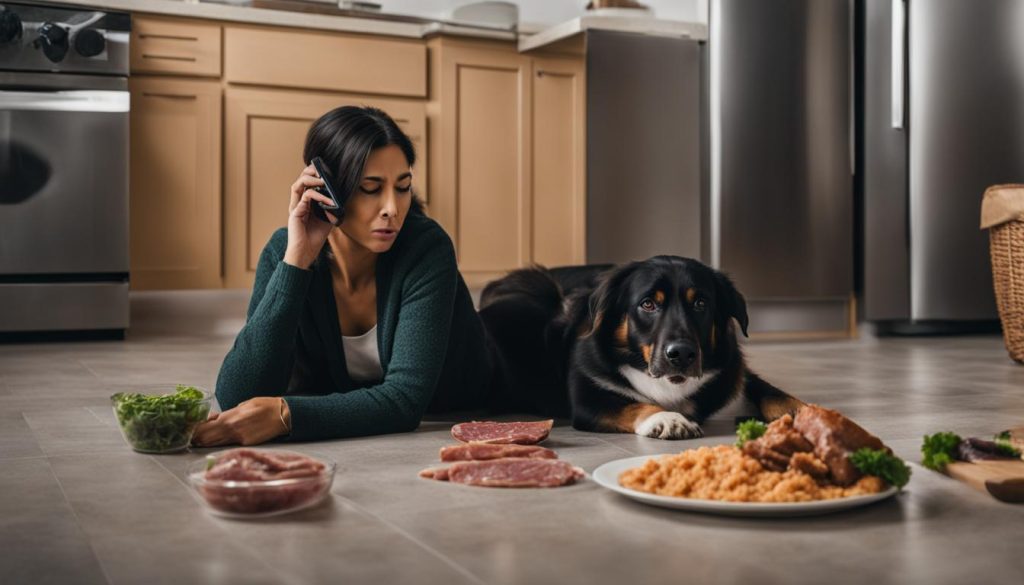In this comprehensive guide, I will answer the question: can dogs eat lunch meat? As a professional in the field of pet care, it is important to understand the potential risks associated with feeding our furry friends certain foods. Lunch meat, although commonly enjoyed by humans, may not be the best choice for our canine companions. Let’s explore why lunch meat may not be safe for dogs and discover healthier alternatives to incorporate into their diets.
Key Takeaways
- Lunch meat can contain harmful ingredients such as sodium nitrite, seasonings, and additives that can be detrimental to dogs’ health.
- The high sodium content in lunch meat can lead to sodium ion poisoning and excessive thirst in dogs.
- Lunch meat’s high-fat content can contribute to obesity and pancreatitis in dogs.
- Feeding dogs lunch meat can pose risks of listeriosis, a bacterial infection caused by the bacterium listeria.
- Healthier alternatives to lunch meat for dogs include cooked eggs, natural unsalted peanut butter, and lean meats like chicken and turkey.
Why Isn’t Lunch Meat Good for Dogs?

Feeding lunch meat to dogs is not recommended due to the presence of harmful ingredients. One of the main culprits is sodium nitrite, a preservative commonly used in lunch meats. While this chemical helps extend the shelf life of the meat, it can be toxic to dogs when ingested in large amounts. Sodium nitrite can lead to a condition called methemoglobinemia, which reduces the amount of oxygen that red blood cells can carry.
In addition to sodium nitrite, lunch meats often contain seasonings and additives that can cause gastrointestinal upset and other health issues in dogs. Ingredients like onions and garlic can be particularly harmful. Both of these foods are part of the Allium family and can cause damage to red blood cells, leading to anemia in dogs. Other seasonings and additives present in lunch meats have the potential to cause digestive problems, allergic reactions, and even organ damage in dogs.
The high sodium content in lunch meat is another reason why it is not suitable for dogs. Consuming excessive sodium can lead to increased thirst, frequent urination, and potential dehydration. Dogs have different sodium requirements compared to humans, and their bodies are not well equipped to handle the high levels found in processed lunch meats. Therefore, it is best to avoid feeding lunch meat to dogs and explore healthier alternatives for their nutritional needs.
Health Risks Associated with Lunch Meat
Feeding dogs lunch meat can pose several health risks. The high sodium content in lunch meat can lead to sodium ion poisoning and excessive thirst in dogs. Sodium ion poisoning can cause symptoms such as vomiting, diarrhea, seizures, and even death. Additionally, lunch meat’s high-fat content can contribute to obesity and pancreatitis in dogs. Obesity can lead to a range of health issues, including diabetes, joint problems, and heart disease. Pancreatitis, on the other hand, is a painful inflammation of the pancreas that can cause severe abdominal pain, vomiting, and loss of appetite.
“Feeding dogs lunch meat can have serious consequences for their health. The combination of high sodium and fat content can lead to conditions like sodium ion poisoning and obesity. These health risks should not be taken lightly, and pet owners should be aware of the potential dangers of feeding lunch meat to their dogs.”
In addition to sodium and fat, lunch meat can contain harmful bacteria such as listeria. Listeria can cause listeriosis in dogs, which can lead to symptoms such as diarrhea, nausea, fever, and even septicemia. It is important to note that dogs have a higher risk of listeriosis compared to humans, as their immune systems may not be able to effectively fight off the infection.
Given the health risks associated with lunch meat, it is best to avoid feeding it to your dog altogether. Instead, opt for healthier protein options such as cooked chicken or turkey. These lean meats provide essential nutrients for your dog without the excessive sodium and fat content found in lunch meat.
| Health Risks of Lunch Meat for Dogs | Dangers |
|---|---|
| Sodium ion poisoning | Excessive thirst, vomiting, diarrhea, seizures |
| Obesity | Diabetes, joint problems, heart disease |
| Pancreatitis | Abdominal pain, vomiting, loss of appetite |
| Listeriosis | Diarrhea, nausea, fever, septicemia |
What to Do If Your Dog Ate Lunch Meat

If your dog has accidentally eaten a small amount of lunch meat, there is usually no need to panic. However, if your dog has consumed a large quantity of lunch meat or is showing symptoms of distress, it is important to take appropriate steps to ensure their well-being.
Here are some recommended steps to take if your dog ingests lunch meat:
- Assess the situation: Determine the amount of lunch meat your dog has eaten and whether they are exhibiting any unusual symptoms. This will help you gauge the level of concern and the urgency of the situation.
- Contact your veterinarian: If your dog has consumed a significant amount of lunch meat or is showing signs of distress such as vomiting, diarrhea, excessive thirst, or lethargy, it is best to seek professional advice. Your veterinarian will be able to provide guidance and recommend the appropriate course of action.
- Monitor your dog: Keep a close eye on your dog’s behavior and monitor any changes in their condition. Note any additional symptoms or concerns that may arise.
- Follow your veterinarian’s guidance: If your veterinarian advises further action, such as inducing vomiting or bringing your dog in for an examination, it is important to follow their instructions accordingly. They will be able to assess your dog’s specific situation and provide the most appropriate care.
Remember, it is always best to err on the side of caution when it comes to your dog’s health. If you have any doubts or concerns regarding your dog’s consumption of lunch meat, reaching out to a veterinary professional is the wisest course of action.
Table: Steps to Take If Your Dog Ingests Lunch Meat
| Steps | Description |
|---|---|
| 1. | Assess the situation |
| 2. | Contact your veterinarian |
| 3. | Monitor your dog |
| 4. | Follow your veterinarian’s guidance |
Better Alternatives to Lunch Meat

When it comes to feeding your dog, there are healthier alternatives to lunch meat that provide better nutritional value. These options are lower in sodium and fat, ensuring your dog maintains a balanced and healthy diet. Consider incorporating the following protein sources into your dog’s meals:
Cooked Eggs
Eggs are a great source of protein for dogs. They are easy to prepare and can be cooked in various ways, such as scrambled or boiled. Remember to fully cook the eggs and avoid using any seasoning or additives that may be harmful to your dog.
Natural Unsalted Peanut Butter
Peanut butter is another protein-rich option for dogs. Make sure to choose natural unsalted peanut butter without any added sugars or artificial sweeteners. It can be given to your dog as a treat or mixed into their food for added flavor.
Cooked Boneless Salmon
Salmon is a great source of omega-3 fatty acids, which provide numerous health benefits for dogs. Remove the bones and cook the salmon thoroughly before serving it to your dog. Avoid using any seasonings or oils that could be harmful.
Cooked Chicken, Pork, Shrimp, and Tuna
Other lean meats such as chicken, pork, shrimp, and tuna can also be included in your dog’s diet. However, it is important to remove any bones and cook these meats thoroughly to ensure they are safe for consumption. Avoid using seasonings, spices, or additives that may be harmful to your dog.
By choosing these healthier alternatives to lunch meat, you can provide your dog with the necessary protein while minimizing the risk of harmful ingredients and health issues.
The Risks of Giving Dogs Ham

Ham is not recommended for dogs due to its high salt and fat content. Regular consumption of ham can lead to obesity, pancreatitis, and other health issues. The high salt content in ham can cause excessive thirst, sodium ion poisoning, and other complications in dogs. The high-fat content can contribute to obesity and pancreatitis, potentially life-threatening conditions for dogs.
Feeding ham to dogs can also increase their risk of developing heart disease and other cardiovascular problems. The rich fat content in ham can lead to weight gain, which puts additional strain on the heart. Moreover, ham often contains preservatives, additives, and seasonings that can be harmful to dogs’ digestive system and overall health.
It’s important to remember that dogs have different nutritional needs than humans, and what may be safe and enjoyable for us may be harmful to them. When it comes to ham, it’s best to err on the side of caution and avoid feeding it to your furry friend altogether.
| Risks of Giving Dogs Ham | Effects on Dogs’ Health |
|---|---|
| High salt content | – Excessive thirst – Sodium ion poisoning – Dehydration |
| High fat content | – Obesity – Pancreatitis – Cardiovascular problems |
| Potentially harmful additives | – Digestive issues – Overall health complications |
Risks of Feeding Ham to Dogs
- Excessive thirst and dehydration
- Sodium ion poisoning
- Obesity and pancreatitis
- Cardiovascular problems
- Digestive issues
- Overall health complications
Guidelines for Feeding Dogs Ham
When it comes to feeding dogs ham, there are important guidelines to follow to ensure their health and well-being. While ham should not be a regular part of a dog’s diet, small amounts can be given as an occasional treat. It’s essential to be mindful of portion sizes and monitor your dog’s intake to avoid any potential health issues.
The amount of ham a dog can eat depends on their size. Smaller dogs, such as toy breeds, should only have a bite or two of ham. Larger dogs can handle a small slice of ham. It’s crucial not to overfeed your dog with ham, as it can lead to obesity, pancreatitis, and other complications.
It’s important to remember that ham should not be seasoned with spices, herbs, or additives that can be harmful to dogs. Plain, unseasoned ham is the safest option. Additionally, it’s recommended to remove any fatty or salty parts of the ham before feeding it to your dog.
| Dog Size | Portion Size |
|---|---|
| Toy Breeds | A bite or two |
| Small to Medium Breeds | A small slice |
| Large Breeds | A larger slice |
Always remember to consult with your veterinarian before introducing any new foods into your dog’s diet. They can provide personalized guidelines based on your dog’s specific needs, taking into consideration factors such as age, size, and overall health. By following these guidelines and practicing moderation, you can safely treat your dog to a small amount of ham on special occasions.
Can Dogs Eat Honey-Baked Ham?

Honey-baked ham is not safe for dogs to consume due to its high sugar, salt, and fat content. The combination of these ingredients can pose various health risks to dogs, including obesity and pancreatitis. The excessive sugar in honey-baked ham can lead to weight gain and potentially contribute to the development of diabetes in dogs. Additionally, the high salt content can lead to dehydration and sodium ion poisoning, which can be life-threatening for dogs.
Furthermore, the high-fat content in honey-baked ham can put strain on a dog’s pancreas, potentially leading to pancreatitis. This condition is characterized by inflammation of the pancreas and can cause severe abdominal pain, vomiting, and loss of appetite in dogs. It is important to note that even a small amount of honey-baked ham can be harmful to dogs, as their bodies are not equipped to handle the excessive levels of sugar, salt, and fat.
If you are looking for alternative treats for your dog, it is recommended to opt for lean meats such as cooked chicken or turkey. These options provide essential proteins without the added sugars, salts, and fats found in honey-baked ham. Remember to always consult with your veterinarian to ensure you are providing a balanced and suitable diet for your furry companion.
Table: Risks of Dogs Eating Honey-Baked Ham
| Risks | Description |
|---|---|
| Obesity | The high fat content in honey-baked ham can contribute to weight gain and obesity in dogs. |
| Pancreatitis | The high fat content in honey-baked ham can put strain on a dog’s pancreas, leading to inflammation and pancreatitis. |
| Sodium Ion Poisoning | The high salt content in honey-baked ham can cause dehydration and sodium ion poisoning, which can be life-threatening for dogs. |
| Diabetes | The excessive sugar in honey-baked ham can contribute to the development of diabetes in dogs. |
“Feeding honey-baked ham to dogs can have serious health consequences. It’s best to avoid this food and opt for safer, healthier alternatives.”– Dr. Emily Thompson, DVM
Lean Meat Alternatives for Dogs

When it comes to choosing healthy meat options for dogs, lean meats such as chicken and turkey are excellent alternatives to lunch meat. These lean meats provide essential proteins for dogs without the high levels of sodium and fat found in processed lunch meats. Cooking the meat thoroughly is essential to ensure it is safe for your furry friend to consume. By avoiding the use of spices or additives, you can further ensure that the meat remains healthy for your dog.
Lean meats offer a range of benefits for dogs. They are lower in salt and fat, helping to prevent obesity and reduce the risk of pancreatitis, a potentially life-threatening condition. These meats also provide high-quality protein, which is vital for your dog’s overall health and well-being. As a responsible pet owner, it’s important to prioritize their nutrition and choose lean meat options that will provide them with the nutrients they need.
Incorporating lean meats into your dog’s diet can be done in various ways. You can cook chicken or turkey breast and serve it as a standalone meal or mix it with other dog-friendly ingredients such as vegetables and whole grains. Remember to avoid seasoning the meat with any harmful spices or additives, as these can cause gastrointestinal upset and other health issues for your dog.
| Lean Meat Options for Dogs | Description |
|---|---|
| Chicken Breast | A lean source of protein that is easily digestible for dogs. |
| Turkey Breast | Low in fat and a good source of essential nutrients for dogs. |
Remember, it’s always best to consult with your veterinarian before making any significant changes to your dog’s diet. They can provide personalized guidance based on your dog’s specific needs and ensure that their diet remains balanced and healthy.
Wrapping Up
After careful consideration, it is clear that lunch meat, including ham, is not recommended for dogs. The high sodium, fat, and harmful ingredient content in lunch meat can lead to serious health issues for our furry friends. Regular consumption of lunch meat can result in obesity, pancreatitis, and sodium ion poisoning in dogs.
It is crucial to prioritize a healthy diet for our dogs to ensure their overall well-being. Instead of feeding them lunch meat, we should opt for healthier protein options, such as cooked chicken or turkey. These lean meats provide essential proteins while being lower in salt and fat compared to ham. It is vital to cook the meat thoroughly and avoid seasoning with spices or additives that may be harmful to our dogs.
When determining the best diet for your dog, it is always recommended to consult with a veterinarian. They can provide guidance on a balanced and suitable diet for your furry friend. Ensuring that our dogs receive the appropriate nutrition will contribute to their longevity and overall happiness.
FAQ
Can dogs eat lunch meat?
No, lunch meat is not recommended for dogs due to its harmful ingredients and high sodium and fat content.
Why isn’t lunch meat good for dogs?
Lunch meat contains potentially harmful ingredients such as sodium nitrite, seasonings, and additives that can cause health issues in dogs.
What are the health risks associated with lunch meat for dogs?
Lunch meat can lead to sodium ion poisoning, gastrointestinal upset, obesity, pancreatitis, and listeriosis in dogs.
What should I do if my dog ate lunch meat?
If your dog consumed a large quantity of lunch meat or is exhibiting distressing symptoms, contact your veterinarian for guidance.
What are some better alternatives to feeding dogs lunch meat?
Healthier protein options for dogs include cooked eggs, natural unsalted peanut butter, cooked boneless salmon, cooked chicken, cooked pork, sardines, cooked shrimp, and cooked tuna.
What are the risks of giving dogs ham?
Ham is high in salt and fat, which can lead to obesity, pancreatitis, and other health issues in dogs.
How much ham can dogs eat?
Dogs should only consume small amounts of ham as an occasional treat, and portion sizes should be determined based on the size of the dog.
Can dogs eat honey-baked ham?
No, honey-baked ham is not recommended for dogs due to its high sugar, salt, and fat content.
What are some lean meat alternatives for dogs?
Lean meats such as chicken and turkey are healthier alternatives for dogs compared to ham. These meats should be cooked thoroughly without any spices or additives.
What is the conclusion regarding dogs and lunch meat?
Lunch meat, including ham, is not recommended for dogs due to its high sodium, fat, and harmful ingredient content. It’s best to choose healthier protein options and consult with a veterinarian for a balanced diet for your dog.






